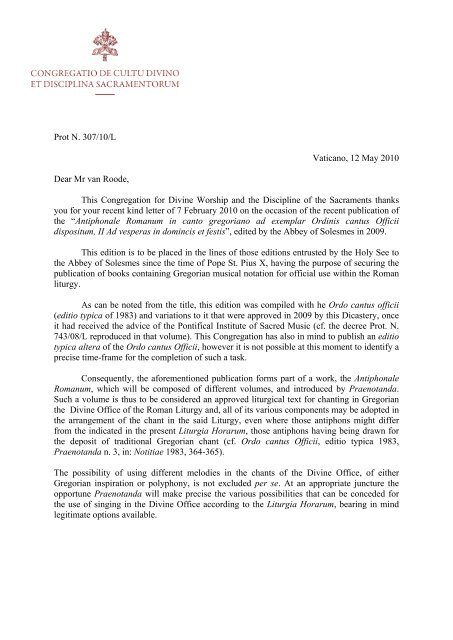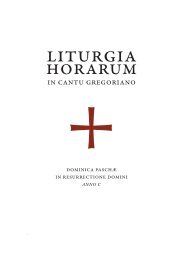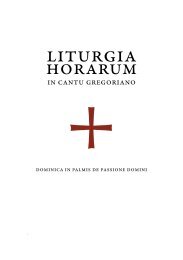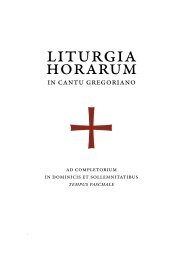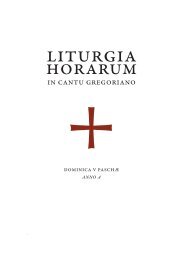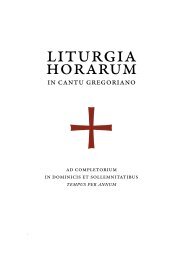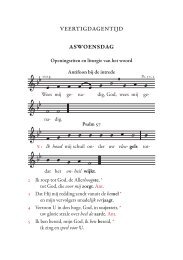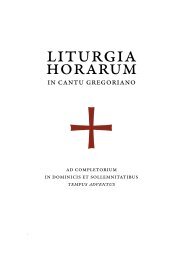Prot N 307 10 L
Prot N 307 10 L
Prot N 307 10 L
Create successful ePaper yourself
Turn your PDF publications into a flip-book with our unique Google optimized e-Paper software.
<strong>Prot</strong> N. <strong>307</strong>/<strong>10</strong>/L<br />
Vaticano, 12 May 20<strong>10</strong><br />
Dear Mr van Roode,<br />
This Congregation for Divine Worship and the Discipline of the Sacraments thanks<br />
you for your recent kind letter of 7 February 20<strong>10</strong> on the occasion of the recent publication of<br />
the “Antiphonale Romanum in canto gregoriano ad exemplar Ordinis cantus Officii<br />
dispositum, II Ad vesperas in domincis et festis”, edited by the Abbey of Solesmes in 2009.<br />
This edition is to be placed in the lines of those editions entrusted by the Holy See to<br />
the Abbey of Solesmes since the time of Pope St. Pius X, having the purpose of securing the<br />
publication of books containing Gregorian musical notation for official use within the Roman<br />
liturgy.<br />
As can be noted from the title, this edition was compiled with he Ordo cantus officii<br />
(editio typica of 1983) and variations to it that were approved in 2009 by this Dicastery, once<br />
it had received the advice of the Pontifical Institute of Sacred Music (cf. the decree <strong>Prot</strong>. N.<br />
743/08/L reproduced in that volume). This Congregation has also in mind to publish an editio<br />
typica altera of the Ordo cantus Officii, however it is not possible at this moment to identify a<br />
precise time-frame for the completion of such a task.<br />
Consequently, the aforementioned publication forms part of a work, the Antiphonale<br />
Romanum, which will be composed of different volumes, and introduced by Praenotanda.<br />
Such a volume is thus to be considered an approved liturgical text for chanting in Gregorian<br />
the Divine Office of the Roman Liturgy and, all of its various components may be adopted in<br />
the arrangement of the chant in the said Liturgy, even where those antiphons might differ<br />
from the indicated in the present Liturgia Horarum, those antiphons having being drawn for<br />
the deposit of traditional Gregorian chant (cf. Ordo cantus Officii, editio typica 1983,<br />
Praenotanda n. 3, in: Notitiae 1983, 364-365).<br />
The possibility of using different melodies in the chants of the Divine Office, of either<br />
Gregorian inspiration or polyphony, is not excluded per se. At an appropriate juncture the<br />
opportune Praenotanda will make precise the various possibilities that can be conceded for<br />
the use of singing in the Divine Office according to the Liturgia Horarum, bearing in mind<br />
legitimate options available.
It is clear that in an official publication of material as important as liturgical music and<br />
the chanting of texts in the latin language, there is demanded the maximum attentiveness and<br />
information such that this particular instrument which is being offered to the Church might be<br />
truly adapted in such a way as to conserve and promote the treasury of Gregorian chant<br />
patrimony, and that this can become an inspiration and also a leaven for the development of a<br />
music which is truly liturgical, sacral – something which is very necessary today in the many<br />
parts of the Catholic world.<br />
With every best wish, I remain,<br />
Yours devotedly in the Lord,<br />
(Msgr. Juan Miguel Ferrer Grenesche)<br />
Sotto-Segretario


